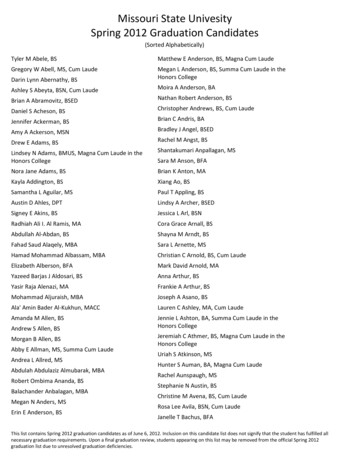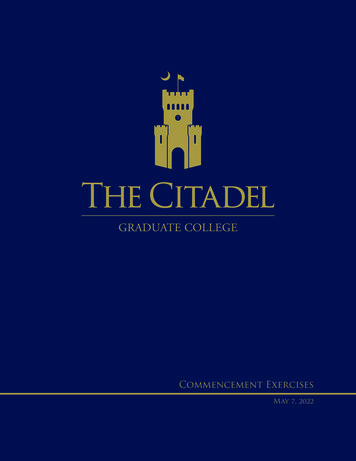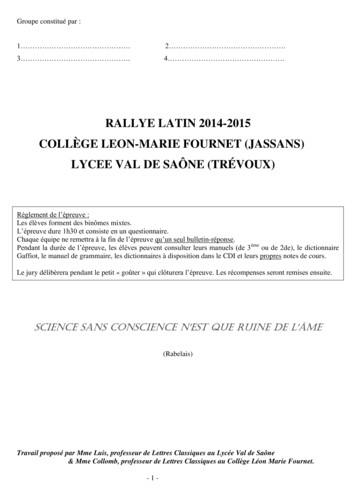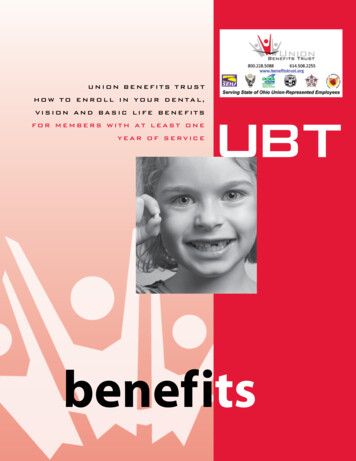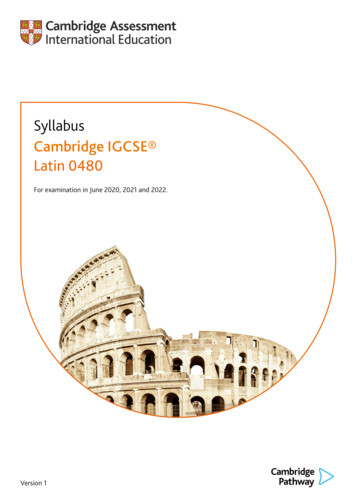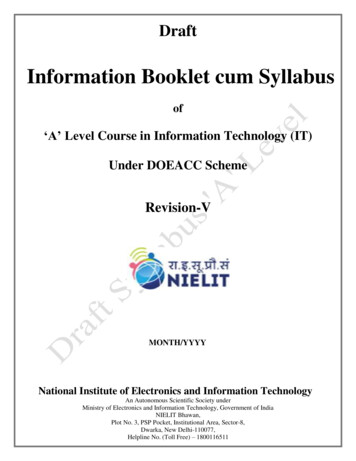
Transcription
DraftInformation Booklet cum Syllabusof‘A’ Level Course in Information Technology (IT)Under DOEACC SchemeRevision-VMONTH/YYYYNational Institute of Electronics and Information TechnologyAn Autonomous Scientific Society underMinistry of Electronics and Information Technology, Government of IndiaNIELIT Bhawan,Plot No. 3, PSP Pocket, Institutional Area, Sector-8,Dwarka, New Delhi-110077,Helpline No. (Toll Free) – 1800116511
National Institute of Electronics and Information Technology‘A’ Level Course in IT under DOEACC Scheme -Revision VCONTENTSSl. No. TITLEPAGENO.Section 1: About NIELIT and ‘A’ Level Course in InformationTechnology under DOEACC Scheme1.1About the Revised Syllabus41.2About NIELIT41.3DOEACC Scheme51.4Objective of Scheme51.551.6‘A’ Level Course in Information Technology under DOEACCSchemePractical1.7Improvement91.8Mini Project101.9Major Project191.10131.11Credit Scheme For ‘A’ Level Course in InformationTechnologyExamination Pattern1.12Practical Examination Scheme181.13Parity Between Revision IV And Revision V of ‘A’ LevelCourse in Information Technology Syllabus19914Section 2: Detailed Information of Modules of ‘A’ Level Course inInformation Technology2.1A1-R5Information Technology Tools and NetworkBasics222.2A2-R5Web Designing and Publishing292.3A3-R5Programming and Problem Solving ThroughPython332.4A4-R5Internet of Things and Its Applications382.5A5-R5Data Structure Through Object OrientedProgramming Language442.6A6-R5Computer Organization and Operating System502.7A7-R5Database Technologies562.8A8-R5Systems Analysis, Design and Testing612.9A9.1-R5Big Data Analytics Using Hadoop66Draft Syllabus of ‘A’ Level Course in Information Technology under DOEACC Scheme Revision VPage 1
National Institute of Electronics and Information Technology‘A’ Level Course in IT under DOEACC Scheme -Revision V2.10A10.1-R5Data Science Using Python712.11A9.2-R5Web Application Using PHP762.12A10.2-R5Full Stack Web Development Using MVCFramework812.13A9.3-R5Data Communication and Networking872.14A10.3-R5Information Security Management932.15A9.4-R5Internet Of Things(IoT): A Practical Approach1002.16A10.4-R5Internet Of Things(IoT) Using Raspberry Pi1052.17A9.5-R5Artificial Intelligence Concepts and RProgramming1112.18A10.5-R5Artificial Intelligence Using Python114Draft Syllabus of ‘A’ Level Course in Information Technology under DOEACC Scheme Revision VPage 2
National Institute of Electronics and Information Technology‘A’ Level Course in Information Technology under DOEACC Scheme -Revision VSection 1About NIELIT and ‘A’ Level Course inInformation TechnologyunderDOEACC SchemeDraft Sy llabus A LevelDraft Syllabus of ‘A’ Level (IT) under DOEACC Scheme Revision VPage 3
National Institute of Electronics and Information Technology‘A’ Level Course in Information Technology under DOEACC Scheme -Revision V1.1. About the Revised SyllabusThe fourth revised version of ‘A’ Level course in Information Technology syllabus underDOEACC Scheme came into effect in January 2010 examinations. Since then, muchadvancement has been observed in the area of Information Technology. The need ofindustry has also changed with the availability of new and advanced technologies andtools. With the advancement in technologies, the software development practices havealso changed. This also has led to change in job profile. Different job roles requiresdifferent skills. Moreover, the digital initiatives taken by Government have also changedthe way the business is taking place these days. These factors have led to bringing therevision in syllabus of DOEACC ‘A’ Level (IT) course.This document presents the fifth revised version of DOEACC ‘A’ Level course inInformation Technology syllabus which becomes effective for teaching with immediateeffect. The syllabus of ‘A’ Level course is designed to enhance the skills of students so asto enable them to solve problem using Information Technology (IT) tools. The selflearning approach is built into the syllabus enabling the learners to update themselves onthe changing technologies in their area of work.1.2. About NIELITNational Institute of Electronics and Information Technology, NIELIT, (ErstwhileDOEACC Society) is an autonomous scientific society of the Ministry of Electronics &Information Technology, Government of India. The Society is registered under theSocieties Registration Act, 1860. NIELIT was set up to carry out Human ResourceDevelopment and related activities in the area of Information, Electronics &Communications Technology (IECT). NIELIT is engaged both in Formal & Non-FormalEducation in the area of IECT besides development of industry-oriented qualityeducation and training programmes in the state-of-the-art areas. NIELIT has endeavouredto establish standards to be the country’s premier institution for Examination andCertification in the field of IECT. It is also one of the National Examination Body, whichaccredits institutes/organizations for conducting courses in IT and Electronics in the nonformal sector.Draft Sy llabus A LevelOver the last three decades, NIELIT has acquired very good expertise in IT trainingthrough its wide repertoire of courses. These courses are as under. ‘O’ Level (Foundation) –NSQF aligned course at Level 5 ‘A’ Level (Advance Diploma) - NSQF aligned course at Level 6 ‘B’ Level (MCA equivalent) - NSQF aligned course at Level 7 ‘C’ Level (M-Tech level) - NSQF aligned course at Level 8 Digital Literacy Courseso ACC (Awareness in Computer Concepts)o BCC (Basic Computer Course)o CCC (Course on Computer Concepts) –NSQF aligned at Level 3o CCC (Course on Computer Concepts Plus)o Expert Computer CourseDraft Syllabus of ‘A’ Level (IT) under DOEACC Scheme Revision VPage 4
National Institute of Electronics and Information Technology‘A’ Level Course in Information Technology under DOEACC Scheme -Revision VAt present, NIELIT is operating from offices located at Agartala, Aizawl, Ajmer,Aurangabad, Bhubaneswar, Calicut, Chandigarh, Chennai, Chuchuyimlang,Churachandpur, Delhi, Dibrugarh, Gangtok, Gorakhpur, Guwahati, Haridwar, Imphal,Itanagar, Jammu, Jorhat, Kohima, Kolkata, Kokrajhar, Kurukshetra, Leh, Lucknow,Lunglei, Mandi, Pasighat, Patna, Pali, Ranchi, Ropar, Senapati, Shillong, Shimla, Silchar,Srinagar, Tezpur, Tura, Tezu with its Headquarters at New Delhi. It is also wellnetworked throughout India with the presence of about 700 institutes. TheHeadquarters is situated at NIELIT Bhawan, Plot No. 3, PSP Pocket, Institutional Area,Sector 8, Dwarka, New Delhi – 110 077.1.3. DOEACC SchemeDOEACC was a joint scheme of the Ministry of Electronics & Information Technology,and All India Council for Technical Education (AICTE), Govt. of India.1.4. Objective of SchemeThe objective of the Scheme is to generate skilled manpower in the area of InformationTechnology (IT) and Electronics at the national level by utilizing the facilities andinfrastructure available with the institutions/organizations in the non-formal sector.NIELIT is managed and administered by a Governing Council which consists of eminentacademicians and professionals from IT and Electronics industries. Minister forElectronics & Information Technology, Government of India, is the Chairman of theGoverning Council. The Director General is the Chief Executive Officer of the Societyand manages day to day affairs of the Society. Manifold functions of the DOEACCScheme are:i. Accreditationiii. Examinationii. Registrationiv. CertificationDraft Sy llabus A Level1.5. ‘A’ Level Course in Information Technology under DOEACCScheme1.5.1. Objective of ‘A’ Level Course in Information TechnologyThe objective of the course is to equip a student with necessary skills as per following jobrole based on specialisation attained.i.Freelancer (For self employed)ii.Full Stack Developeriii. Data Scientist/Analystiv.IoT Architectv.IoT Developervi.Business Intelligence Analystvii.Information Security Analyst1.5.2. Structure of ‘A’ Level Course in Information Technology underDOEACC SchemeThe revised syllabus (Revision V) of ‘A’ Level course consists of eight compulsorytheory modules. The first four modules are that of all four modules of ‘O’ Level (IT)Draft Syllabus of ‘A’ Level (IT) under DOEACC Scheme Revision VPage 5
National Institute of Electronics and Information Technology‘A’ Level Course in Information Technology under DOEACC Scheme -Revision VRevision V, six specialized areas (students to pick one specialized area) each consistingof two modules, two practical papers and one project. The structure of the ‘A’ Level inInformation Technology syllabus is indicated below:-Structure of ‘A’ Level Course in InformationTechnology Revision V1.2.3.4.A1-R5: Information Technology Tools and Network BasicsA2-R5: Web Designing & PublishingA3-R5: Programming and Problem Solving through PythonA4-R5: Internet of Things and its ApplicationsFour modules of ‘O’Revision V(Mandatory)5.A5-R5: Data Structure Though Object OrientedProgramming LanguageA6-R5: Computer Organization and Operating SystemA7-R5: Database TechnologiesA8-R5: Systems Analysis, Design and TestingAnother set of four mandatorymodules6.7.8.Specialized Area: Data AnalyticsA9.1-R5 : Big Data Analytics using HadoopA10.1-R5 : Data Science using PythonDraft Sy llabus A LevelFor module 9 and 10,student will have to selectone specialized group outof six groups.Each specialized groupconsists of two modules.Both the modules withinselected specialized groupare mandatory to qualify‘A’ Level (IT)Note: Two practicalpapers, one mini projectand one major project inspecialized area aremandatory to qualify ‘A’Level (IT)Specialized Area: Web Application DevelopmentA9.2-R5 : Web Application using PHPA10.2-R5 : Full Stack Web Application using MVCSpecialized Area: Information SecurityA9.3-R5 : Data Communication and NetworkingA10.3-R5: Information Security ManagementSpecialized Area: Internet of ThingsA9.4-R5 :Internet of Things (IoT): A PracticalApproachA10.4-R5: Internet of Things (IoT) using Raspberry PiSpecialized Area: Artificial IntelligenceA9.5-R5 : Artificial Intelligence Concepts and RProgrammingA10.5-R5: Artificial Intelligence Using PythonDraft Syllabus of ‘A’ Level (IT) under DOEACC Scheme Revision VPage 6
National Institute of Electronics and Information Technology‘A’ Level Course in Information Technology under DOEACC Scheme -Revision V1.5.3. Sequence of Modules TrainingThe suggestive sequence to cover all the modules of ‘A’ Level course in InformationTechnology along with learning hours is listed g TotalHoursLearning(Practical/ HoursTutorials/Project)Semester IA1-R5Information Technology Toolsand Network Basics4872120A2-R5Web Designing & Publishing4872120A6-R5Computer Organization andOperating SystemDatabase 2120A7-R5Semester IIA3-R5A4-R5Programming and ProblemSolving through PythonInternet of Things and itsApplicationsData Structure Though ObjectOriented ProgrammingLanguageOne module out of A9.1-R5,A9.2-R5, A9.3-R5, A9.4-R5and A9.5-R5Practical based on A1-R5, A2R5 , A3-R5 and A4-R5Practical based on A5-R5, A6R5 and A7-R5Mini ProjectDraft Sy llabus A LevelA5-R5A9.X-R5PR-IPR-IIPJ-I50Semester IIIA8-R5A10.X-R5PJ-IISystems Analysis, Design andTestingOne module out of A10.1-R5,A10.2-R5, A10.3-R5, A10.4R5 and A10.5-R5Major Project (350 hours)based on specialized area.Total48721204872120035035048011101590Draft Syllabus of ‘A’ Level (IT) under DOEACC Scheme Revision VPage 7
National Institute of Electronics and Information Technology‘A’ Level Course in Information Technology under DOEACC Scheme -Revision V1.5.4.Sequence of Modules Training After ‘O’ Level (IT)The suggestive sequence to cover all the modules of ‘A’ Level course in InformationTechnology for those candidates who join ‘A’ level after passing ‘O’ Level (IT) coursealong with learning hours is listed g TotalHoursLearning(Practical/ HoursTutorials/Project)Semester IA5-R5A6-R5A7-R5A9.X-R5PR-IIData Structure Though ObjectOriented ProgrammingLanguageComputer Organization andOperating SystemDatabase Technologies487212048721204872120One module out of A9.1-R5,A9.2-R5, A9.3-R5, A9.4-R5and A9.5-R5Practical based on A5-R5, A6R5 and 2048011101590Draft Sy llabus A LevelSemester IIA8-R5A10.X-R5PJ-IISystems Analysis, Design andTestingOne module out of A10.1-R5,A10.2-R5, A10.3-R5, A10.4R5 and A10.5-R5Major Project (350 hours)based on specialized area.Total Learning hours of ‘A’Level after ‘O’ Level (IT)Learning hours for ‘O’ Level(IT)TotalDraft Syllabus of ‘A’ Level (IT) under DOEACC Scheme Revision VPage 8
National Institute of Electronics and Information Technology‘A’ Level Course in Information Technology under DOEACC Scheme -Revision VList of Specialized AreasData AnalyticsA9.1-R5Big Data Analytics using HadoopA10.1-R5Data Science using PythonWeb ApplicationsA9.2-R5Web Application using PHPA10.2-R5Full Stack Web Development using MVC FrameworkInformation SecurityA9.3-R5Data Communication and NetworkingA10.3-R5Information Security ManagementInternet of ThingsA9.4-R5Internet of Things (IoT) a Practical ApproachA10.4-R5Internet of Things (IoT)using Raspberry PiArtificial IntelligenceDraft Sy llabus A LevelA9.5-R5Artificial Intelligence Concepts and R ProgrammingA10.5-R5Artificial Intelligence using Python1.5.5. Duration of the CourseThe duration of ‘A’ level Course in Information Technology is 1200 learning hours and390 hours of projects. The minimum period to cover contents of ‘A’ Level Course inInformation Technology is one and half year. The minimum period to cover contents of‘A’ Level course in Information Technology is one year for those candidates who registerthemselves in ‘A’ Level course in Information Technology after passing ‘O’ Level (IT).1.6. PracticalThe students have to devote 60% of the total time allotted to each module of the coursefor the practical sessions. Practical assignments have been worked out for each theorymodule and given in this booklet.1.7. ImprovementThe candidates are allowed to improve his/her grade in one subject immediately afterclearing all the theory papers (immediate to last examination where the candidate hascleared his/her last paper).Draft Syllabus of ‘A’ Level (IT) under DOEACC Scheme Revision VPage 9
National Institute of Electronics and Information Technology‘A’ Level Course in Information Technology under DOEACC Scheme -Revision V1.8. Mini ProjectThe candidate registered in ‘A’ Level in Information Technology (IT) under DOEACCScheme is required to submit two projects, one mini project and other major project.Guidelines to submit the Mini project are given in Information Brochure cum Syllabusbooklet of ‘O’ Level (IT) –Revision V under DOEACC Scheme.1.9. Major ProjectNIELIT curriculum has a Major project as an important component of ‘A’ Level coursein Information Technology. The Project is carried out by the student under guidance andsupport of faculty and management of the respective institute. It is felt that such a projectprovides an opportunity to the student to apply his/her knowledge and skills to real lifeproblems (including oral and written communication skills), and as such the projectshould be given utmost importance and priority both by the students as well as institutionfaculty / management in respect of its identification, planning and implementation.1.9.1. Objective of the Major ProjectThe aim of the project is to give the students an integrated experience in solving a reallife problem by applying knowledge and skills gained on completion of theory papers in acourse at a given Level. IInt provides an occasion for students to develop written andcommunication skills, Project also helps the students to realize the importance ofresource and time management, ownership of task towards deliverables, innovation andefficiency in task management apart from presentation skills. It also provides a goodopportunity for students to build, enhance and sustain high levels of professional conductand performance and evolves a problem solver frame of mind in student. It is also feltthat taking up the project by a student prepares him for a job in industry and elsewhere.Draft Sy llabus A Level1.9.2. Who could be GuideWho could be a Supervisor / Guide A guide for ‘A’ Level (IT) should be a person withDOEACC ‘B’ level/ MCA/ B.Tech/ equivalent/higher qualification and adequateexperience (minimum 3 years) in the area in which the student has chosen the Project. Inthe case of a candidate from an - 5 - accredited institute, the institute concerned willrender all help including the nomination of the Supervisor.1.9.3. Type of Major ProjectStudent can develop a project of any type like browser based, mobile based or clientserver architecture base application. However, it should be based on specialized areawhich the student has opted. For example, if a student has opted Artificial Intelligence(AI), he/she has to develop a major project in the application areas of AI.1.9.4. Time of Submission of Major Project for ‘A’ Level Course inInformation Technology‘A’ Level (IT) student can submit the project only after clearing 5 papers of the ‘A’ LevelCourse in Information Technology and appear in both the modules of specialized areawhich the student has opted. The project should be of minimum 350 man-hours andcarries a total of 100 marks (80% for the project evaluation and 20% for the viva-voce).Draft Syllabus of ‘A’ Level (IT) under DOEACC Scheme Revision VP a g e 10
National Institute of Electronics and Information Technology‘A’ Level Course in Information Technology under DOEACC Scheme -Revision V1.9.5. Some Important Notes While Preparing the Project ProposalThe following suggested guidelines may be followed in preparing the Final ProjectReport:Good quality white executive bond paper A4 size should be used for typing andduplication. Care should be taken to avoid smudging while duplicating the copies.Page Specification: (Written paper and source code) Left margin 3.0 cms Right margin 3.0 cms Top margin 2.7 cms Bottom margin 2.7 cms Page numbers – All text pages as well as Program source code listing should benumbered at the bottom center of the pages.1.9.6. Submission of Project Report to NIELITThe student will submit his/her project report in the prescribed format along withrequisite fee. The Project Report should include: One hard copy of the Project Report. Soft copy of Project on Optical Drive The Project Report may be about 50 pages (excluding coding).1.9.7. FeesAn applicable fee for submitting ‘A’ Level Project should be remitted to NIELIT in theprescribed mode only on the official website of NIELIT. The applicable fee is availableon web site on NIELIT. The students are advised to check the applicable fee from officialwebsite of NIELIT before remitting the same to NIELIT.Draft Sy llabus A Level1.9.8. Major Project SubmissionThe student undergoing course ‘A’ level Course in Information Technology has to submitproject in order to be ‘A’ Level certified. The project should be original and of real-lifevalue. The project should not be copy of existing material from any other source.The Learners (Students) are expected to carry out a project successfully and submit theproject certificate in the prescribed format from the head of the institute running theaccredited course or the organization of which the learner is an employee. Proforma ofthe Project Completion Certificate is given as follow;Draft Syllabus of ‘A’ Level (IT) under DOEACC Scheme Revision VP a g e 11
National Institute of Electronics and Information Technology‘A’ Level Course in Information Technology under DOEACC Scheme -Revision VPerforma of the Project Completion Mr./Ms. (NIELIT Registration No. ) inpartial fulfilment of ‘A’ Level Course in Information Technology under DOEACCScheme Examination at has been found satisfactory.This report has not been submitted for any other examination and does not formpart of any other course undergone by the candidate.Draft Sy llabus A LevelSignatureName:(By Head of the Institution) with PROVNo. /FULL No.)OrSignature(Name of Head of the Organization /Division)Division:Organization Name:Address:Draft Syllabus of ‘A’ Level (IT) under DOEACC Scheme Revision VP a g e 12
National Institute of Electronics and Information Technology‘A’ Level Course in Information Technology under DOEACC Scheme -Revision V1.10. Credit Scheme For ‘A’ Level Course in InformationTechnology1.10.1. About Credit SystemA credit system based on the AICTE norms has been introduced for indicating the effortsrequired to pass a specific level of course under the DOEACC Scheme. Award of creditto a student will facilitate measurement/comparison of study hours including TheoryLectures, Tutorials and Practical Assignments put in a given module/paper/subject underthe Scheme with similar course in IT in India and abroad. This will also facilitate otherUniversities/ Apex Accrediting bodies to consider academic and professional equivalenceof NIELIT courses. This will also help students/organizations to transfer credits fromNIELIT to other academic bodies and vice-versa for ensuring continuity in education.Following table gives the number of hours of theory lectures, tutorials and practicals perweek to be attended and the credits earned by the student:-1.10.2. Calculation of CreditsSr. No.ModuleCodeModule NameNo. y toolsand NetworkBasics2.A2-R53.No. ofTheory Practical TotalTutorial/ Credits CreditsCreditsPractical/ProjectHours(B)(C (A)/15)(D ((B) /2* 15)(E (C ) (D))4872325Web Designing& Publishing4872325A3-R5Programmingand ProblemSolving throughPython48723254.A4-R5Internet ofThings and itsApplication48723255.A5-R548723256.A6-R5Data StructureThough ion andOperatingSystem4872325Draft Sy llabus A LevelDraft Syllabus of ‘A’ Level (IT) under DOEACC Scheme Revision VP a g e 13
National Institute of Electronics and Information Technology‘A’ Level Course in Information Technology under DOEACC Scheme -Revision V7.A7-R58.A8-R59.A9.x-R510.A10.x-R5 One module outof A10.1-R5,A10.2-R5,A10.3-R5,A10.4-R5 emsAnalysis andDesignOne module outof A9.1-R5,A9.2-R5, A9.3R5, A9.4-R5 andA9.5-R54872325487232548723254872325350Total Credits121262Notes1.One credit is defined as one hour of theory lecture and 2 hours of tutorials/practical/project every week for one semester consisting of 15 weeks.2.Total number of credits earned in a module is calculated using AICTE formula (asapplicable to Under Graduate Courses in IT namely C L (T P)/2 where L, Tand P indicate number of hours per week for Lectures, Tutorials and Practical.Hours spent during Project development is considered under Tutorials andPractical.3.The credit scheme has been implemented since July, 2003 examinations.4.Fractions in Credits have been rounded to nearest integer.Draft Sy llabus A Level1.11. Examination PatternThe theory examination for each module under the fifth revised syllabus would be forduration of three hours and the total marks for each subject would be 100. Each Practicalexamination will be of three hours duration and would carry 100 marks. The teaching andexamination for ‘A’ Level modules in IT will start once the notification is issued byNIELIT.Dates for the various activities related with examinations will be announced on NIELITwebsite, well in advance of the examinations.Laboratory/ Practical work will be conducted at Institutions / organizations, which arerunning the course. NIELIT will be responsible for holding the examination for theoryand practical both for the students from Accredited Centres and student at large.Draft Syllabus of ‘A’ Level (IT) under DOEACC Scheme Revision VP a g e 14
National Institute of Electronics and Information Technology‘A’ Level Course in Information Technology under DOEACC Scheme -Revision V1.11.1. Pass PercentageTo qualify a module, a candidate must have obtained at least 50% in each theory andpractical examination. A successful project complete certificate is mandatory for studentto qualify ‘A’ Level course. Following table shows the marks leInformation Technology tools and Network BasicsWeb Designing & PublishingProgramming and Problem Solving through PythonInternet of Things and its ApplicationData Structure Through Object Oriented ProgrammingLanguageComputer Organization and Operating SystemDatabase TechnologiesSystems Analysis and DesignOne module out of A9.1-R5, A9.2-R5, A9.3-R5, A9.4-R5and A9.5-R5.One module out of A10.1-R5, A10.2-R5, A10.3-R5,A10.4-R5 and A10.5-R5.Practical-1 (Based on Modules A1-R5 to A4-R5)Practical-2 (Based on Modules A5-R5 to A7-R5)Mini ProjectMajor Project based on Specialized AreasTotalDraft Sy llabus A 1001002001500The marks will be translated into grades, while communicating results to the candidates.The gradation structure is as below: Pass PercentageGradeFailed ( % and overS1.10.1. Award of CertificatesThe students would be eligible for the award of ‘A’ Level course in InformationTechnology under DOEACC Scheme certificate on successfully qualifying the eligibilitycriteria along with Theory Examinations of all modules, Practical Examination and theProject. The ‘A’ Level Certificate was recognized as equivalent to Advance DiplomaDraft Syllabus of ‘A’ Level (IT) under DOEACC Scheme Revision VP a g e 15
National Institute of Electronics and Information Technology‘A’ Level Course in Information Technology under DOEACC Scheme -Revision VLevel Course by the Government of India for the purpose of employment videNotification No. F.18-23/92-TD.V/TS dated 1st March, 1995 and F.18-23/92-TD.V/TSIV dated 10th April, 1996 issued by Ministry of Human Resources Development and iscurrently aligned at NSQF (National Skill Qualifications Framework) level 6. Further, inthe certificate, the specialized area will also be mentioned.Student after clearing all the 10 modules, two projects and two practical examinations hasfurther option to appear in additional specialized area. The students interested in gettingcertificate of additional specialized area shall have to clear both the modules of additionalspecialized area. Such students are also required to submit a major project related toadditional specialized area.Student who is registered in ‘A’ Level Course in Information Technology and clears firstfour modules (A1-R5, A2-R5,A3-R5 and A4-R5), Practical, PR-1 and submits miniproject certificate as per requirement of ‘O’ Level (IT) will be awarded ‘O’ Level (IT)certificate provided he/she is eligible for registering in ‘O’ Level (IT).1.10.2. RegistrationRegistration is a pre-requisite for appearing in ‘A’ Level examinations. A candidate canregister at only one level at a time to appear for the examination. Registration is only forcandidates and not for institutes. Candidate has to register with NIELIT through onlineportal.1.10.3. Eligibility CriteriaDraft Sy llabus A LevelThe eligibility criteria for registration at ‘A’ Level are as follows:(i.)Students from Institutes conducting accredited courses:‘O’ Level in Information Technology under DOEACC Scheme. Such candidatesare required to register through NIELIT ‘A’ Level Accredited institute.OrA Government recognized polytechnic engineering diploma after 10 2/ Graduate(may be concurrent). Such candidates are required to register through NIELIT ‘A’Level Accredited institute.Or10 2. Such candidates are required to register through NIELIT ‘A’ LevelAccredited institute. Candidates can pursue graduation in parallel with ‘A’ level(IT) Course. The candidate will be eligible for getting O Level (IT) certificateafter clearing required modules.In each of the above cases, the completion certificate of ‘A’ Level underDOEACC Scheme will be awarded only after successful completion of theacademic stream i.e. polytechnic engineering diploma after 10 2 or degree(Graduation).Draft Syllabus of ‘A’ Level (IT) under DOEACC Scheme Revision VP a g e 16
National Institute of Electronics and Information Technology‘A’ Level Course in Information Technology under DOEACC Scheme -Revision V(ii.)Direct Applicants‘O’ Level in Information Technology under DOEACC Scheme followed by sixmonth experience in IT. Relevant experience connotes job experience in IT,including teaching in a recognized institution as a faculty member, excludescoaching.OrA Government recognized polytechnic engineering diploma after 10 2/ Graduate(may be concurrent) followed by one and half year experience in IT. Relevantexperience connotes job experience in IT, including teaching in a recognizedinstitution as a faculty member, excludes coaching.Or10 2. Candidates can pursue graduation in parallel with ‘A’ level (IT) Coursefollowed by one and half year experience in IT. Relevant experience connotes jobexperience in IT, including teaching in a recognized institution as a facultymember, excludes coaching. The candidate will be eligible for getting O Level(IT) certificate after clearing required modules.In each of the above cases, the completion certificate of ‘A’ Level underDOEACC Scheme will be awarded only after successful completion of theacademic stream i.e. polytechnic engineering diploma after 10 2 or degree(Graduation).Draft Sy llabus A Level1.10.4. Prior Knowledge for Selecting Specialized AreaIn ‘A’ Level Course in Information Technology under DOEACC Scheme, fivespecialized areas are offered. The student has to s
2.14 A10.3-R5 Information Security Management 93 2.15 A9.4-R5 Internet Of Things(IoT): A Practical Approach 100 2.16 A10.4-R5 Internet Of Things(IoT) Using Raspberry Pi 105 2.17 A9.5-R5 Artificial Intelligence Concepts and R Programming 111 2.18 A10.5-R5 Artificial Intelligence Using Python 114


